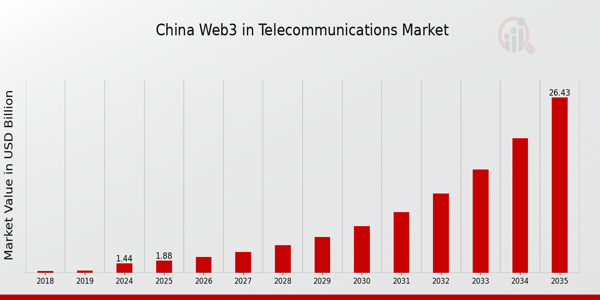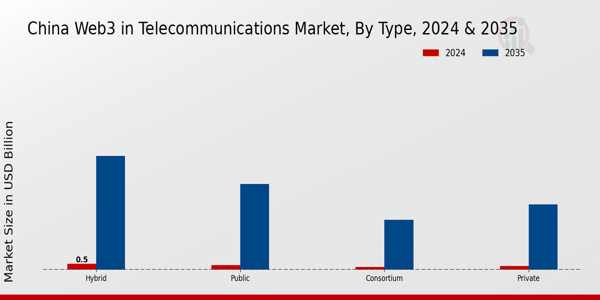China Web3 in Telecommunications Market Overview
As per MRFR analysis, the China Web3 in Telecommunications Market Size was estimated at 0.97 (USD Billion) in 2023. The China Web3 in Telecommunications Market is expected to grow from 1.44(USD Billion) in 2024 to 26.46 (USD Billion) by 2035. The China Web3 in Telecommunications Market CAGR (growth rate) is expected to be around 30.282% during the forecast period (2025 - 2035)
Key China Web3 in Telecommunications Market Trends Highlighted
The China Web3 in Telecommunications Market is witnessing significant growth driven by several key market drivers. One of the primary motivators is the Chinese government's strong push towards digital modernization and the development of a blockchain ecosystem. Policies promoting innovation in telecommunications are creating an environment conducive to the integration of Web3 technologies. Additionally, the increasing adoption of decentralized applications among tech-savvy consumers is fostering a shift from traditional centralized networks to more decentralized systems.
Furthermore, significant investments in telecommunication infrastructure are enabling faster and more reliable internet access, which is essential for Web3 applications, thus enhancing user engagement and participation.There are many chances to take advantage of as the market changes. As people become more aware of issues like data privacy and security in the digital age, businesses can come up with ways to deal with them. There is also room for decentralized finance (DeFi) platforms to grow in the telecommunications industry. This could lead to new ways to make money and better customer service. Companies can use blockchain technology to make their operations more efficient, cut costs, and be more open. Recent trends show that telecom companies and blockchain startups are working together more, which makes it easier to make unique services that are made just for Chinese customers.
Moreover, the introduction of regulations that support the safe and effective use of blockchain technology is paving the way for enhanced trust among users. With an increasing number of players entering the market, the competitive landscape is evolving rapidly, and innovation is becoming a key focus, driven by both competition and consumer demand for more efficient and transparent services.

Source: Primary Research, Secondary Research, Market Research Future Database, and Analyst Review
China Web3 in Telecommunications Market Drivers
Growing Demand for Decentralized Applications
The increasing demand for decentralized applications (dApps) in China is a significant driver for the China Web3 in Telecommunications Market. The rise of dApps is propelled by user preferences for enhanced privacy and security in digital environments. According to reports from the Ministry of Industry and Information Technology of China, the number of blockchain-related patent filings reached over 5,000 in recent years, indicating a strong focus on dApp development.
Established organizations such as China Telecom and China Mobile are investing heavily in Research and Development for blockchain technology, contributing to the broader adoption of Web3 solutions in their telecommunications infrastructure. This push for decentralized applications is also backed by increased internet penetration and smartphone usage across China, which is estimated to be over 1.1 billion mobile users as of 2023. As more users engage with smart contracts and decentralized finance platforms, the demand for telecommunications services that support Web3 technologies will naturally rise, driving significant growth in this market.
Supportive Government Policies
The Chinese government's supportive stance towards blockchain and Web3 technology is another key driver in the China Web3 in Telecommunications Market. Initiatives such as the national blockchain blueprint, which promotes the integration of blockchain across various sectors, are encouraging telecommunication companies to innovate within the Web3 framework.
The State Council's guidelines emphasize the importance of blockchain in fostering technological advancements and efficiency in industries, which aligns with the goals of major telecommunications firms.As China aims to be a leader in blockchain adoption, predicted government investments and supportive regulations will enhance traditional telecom systems by integrating blockchain, thus aiding the market's rapid growth.
Increased Investment in Blockchain Technology
Investment in blockchain technology within China's telecommunications sector is acting as a catalyst for growth in the China Web3 in Telecommunications Market. With sizable financial commitments from leading telecommunications companies such as China Unicom, there is a significant push to enhance network capabilities through blockchain solutions.
China's total investment in blockchain was around $1.6 billion in recent years, as reported by the China Blockchain Application Research Center.This investment trend is anticipated to yield an influx of innovative Web3 services, primarily focusing on secure communication, reduced transaction costs, and improved service efficiency, leading to enhanced customer satisfaction and increased market demand.
China Web3 in Telecommunications Market Segment Insights
Web3 in Telecommunications Market Type Insights
The China Web3 in Telecommunications Market exhibits a diverse segmentation by Type that plays a crucial role in navigating the landscape of telecommunications in the region. As the sector undergoes substantial transformation driven by emerging technologies, the Public segment provides an open-access framework promoting collaboration and community-driven initiatives, which have gained traction among various stakeholders looking for transparency and decentralized governance. In contrast, the Private segment emphasizes enhanced security and data privacy for organizations, catering to businesses that require exclusive environments to manage sensitive information effectively, thus becoming critical for enterprise adoption.The Consortium Type encompasses a blend of both Public and Private features, fostering partnerships between multiple organizations while maintaining standards and protocols agreed upon by all members, which is particularly vital for projects aimed at shared infrastructure development.
Additionally, the Hybrid approach combines elements from all other Types, allowing for tailored solutions that can adapt to the varying needs of industries, enhancing versatility to meet the evolving demands of the telecommunications ecosystem. This segmentation reflects the broader trends in the China Web3 in Telecommunications Market, where innovation, regulatory compliance, and user-centric approaches are essential for growth and development.As digital transformation expands, the importance of seamless integration between these Types can be observed, as they collectively contribute to a more robust and dynamic telecommunications framework in China. Factors such as government policies favoring digital innovation, rising customer expectations for enhanced service delivery, and the increasing interconnectedness of technology are key drivers shaping the landscape of these Types.
Each segment's prominence stems from its ability to cater to specific needs and challenges faced within the telecommunications industry, thus creating a complex yet synergistic environment for future developments.Insights derived from China’s unique market context highlight the need for adaptability and innovation as communication technologies evolve, ultimately enhancing the overall service offering while addressing both user needs and market demands. The combined influence of these Types will undoubtedly play a pivotal role in determining the trajectory of the China Web3 in Telecommunications Market's growth and evolution in the coming years.

Source: Primary Research, Secondary Research, Market Research Future Database, and Analyst Review
Web3 in Telecommunications Market Application Insights
The China Web3 in Telecommunications Market is witnessing significant growth driven by various applications that leverage the unique characteristics of Web3 technology. Among these, Cryptocurrency is becoming essential for digital transactions and decentralized finance solutions in China, often gaining traction among tech-savvy consumers and businesses. Conversational AI is significantly enhancing customer service by providing seamless interactions and improving user engagement, thereby setting out to revolutionize service delivery in the telecommunications sector.Additionally, Data and Transaction Storage solutions are critical in ensuring secure and efficient management of sensitive information within the blockchain ecosystem, addressing growing concerns over data privacy and cybersecurity.
Payments and Smart Contracts are positioned to automate and streamline agreements, making business processes more efficient and reducing operational costs. Other applications within this segment cater to diverse needs, enhancing operational capabilities and underscoring the importance of innovation. As the Chinese government encourages technological advancements, the focus on these applications is facilitating market growth and establishing a robust Web3 ecosystem in the telecommunications landscape.The collective influence of these applications underscores the China Web3 in Telecommunications Market to evolve, providing new opportunities and avenues for stakeholders.
China Web3 in Telecommunications Market Key Players and Competitive Insights
The China Web3 in Telecommunications Market is undergoing a transformative phase influenced by advancements in blockchain technology and the increasing demand for decentralized solutions. This market is characterized by a dynamic landscape where various companies are exploring innovative ways to enhance connectivity, streamline operations, and improve customer engagement through Web3 applications. The competitive landscape is defined by both established telecommunications players and emerging startups, all vying for a share of this rapidly evolving space. Trends are shifting towards integrating decentralized finance (DeFi) services and digital asset management into telecommunications, creating opportunities for unique value propositions.
As companies navigate regulatory frameworks and technological challenges, their strategies will be crucial in determining market leadership and long-term sustainability.JD.com plays a pivotal role in the China Web3 in Telecommunications Market, leveraging its strong e-commerce presence and technological capabilities to explore Web3 applications that enhance customer experiences and optimize supply chain management. The company's strengths lie in its exceptional logistics network and extensive user base, which provide a solid foundation for deploying Web3 solutions. By integrating blockchain technologies, JD.com aims to enhance transparency in transactions and improve the traceability of goods.
Their commitment to innovation and digital transformation allows them to remain competitive in a market increasingly focused on delivering decentralized services, positioning themselves favorably against both traditional competitors and new entrants in the telecommunications sector.Tencent, another major player in the China Web3 in Telecommunications Market, is recognized for its extensive suite of products and services that range from social media platforms to gaming and digital payment solutions. As a pioneering force, Tencent has embraced Web3 principles by investing in decentralized technologies and exploring blockchain applications that can further enhance its existing services. The company has established a strong market presence with its popular applications and a vast ecosystem that facilitates transactions and service interactions.
Tencent’s strength lies in its financial resources and expertise in digital infrastructure, which allow for rapid innovation and expansion. The company has also been involved in several mergers and acquisitions, enabling it to enhance its technological capabilities and broaden its product offerings. Through its strategic initiatives, Tencent continues to play a significant role in shaping the future of telecommunications in a Web3 context, solidifying its competitive edge in the market.
Key Companies in the China Web3 in Telecommunications Market Include
- JD.com
- Tencent
- Bilibili
- China Mobile
- Kuaishou
- Youku
- China Telecom
- Baidu
- Meituan
- Cnooc
- Alibaba
- China Unicom
- Xiaohongshu
- DigiChina
China Web3 in Telecommunications Market Developments
Recent developments in the China Web3 in Telecommunications Market indicate significant advancements by major companies. JD.com, Tencent, and Alibaba have been focusing on leveraging Web3 technologies, which include enhancing user security and data privacy through decentralized solutions. In the area of current affairs, China Mobile and China Telecom are investing in Blockchain-enhanced mobile service platforms to provide innovative applications and improve customer experience. Additionally, Kuaishou and Bilibili are integrating video streaming services with Web3 protocols to enable content creators to have more control over their content.
In terms of mergers and acquisitions, in August 2023, Tencent announced its acquisition of a stake in a Web3 startup to bolster its cloud services and enhance its digital infrastructure. Furthermore, in May 2022, Alibaba and Baidu partnered with local governments to develop smart city initiatives utilizing Web3 technology, exploring new avenues for urban management. Over the past two to three years, the market has experienced substantial growth as companies increasingly embrace decentralized systems, with estimates indicating the value of the Web3 segment in telecommunications is projected to escalate, reflecting a robust transformation in the industry, aligning with China's national strategy on the digital economy.
China Web3 in Telecommunications Market Segmentation Insights
Web3 in Telecommunications Market Type Outlook
- Public
- Private
- Consortium
- Hybrid
Web3 in Telecommunications Market Application Outlook
- Cryptocurrency
- Conversational AI
- Data & Transaction Storage
- Payments
- Smart Contracts
- Others
| Report Attribute/Metric Source: |
Details |
| MARKET SIZE 2023 |
0.97(USD Billion) |
| MARKET SIZE 2024 |
1.44(USD Billion) |
| MARKET SIZE 2035 |
26.46(USD Billion) |
| COMPOUND ANNUAL GROWTH RATE (CAGR) |
30.282% (2025 - 2035) |
| REPORT COVERAGE |
Revenue Forecast, Competitive Landscape, Growth Factors, and Trends |
| BASE YEAR |
2024 |
| MARKET FORECAST PERIOD |
2025 - 2035 |
| HISTORICAL DATA |
2019 - 2024 |
| MARKET FORECAST UNITS |
USD Billion |
| KEY COMPANIES PROFILED |
JD.com, Tencent, Bilibili, China Mobile, Kuaishou, Youku, China Telecom, Baidu, Meituan, Cnooc, Alibaba, China Unicom, Xiaohongshu, DigiChina |
| SEGMENTS COVERED |
Type, Application |
| KEY MARKET OPPORTUNITIES |
Decentralized data management solutions, Enhanced network security protocols, Blockchain-based identity verification, Smart contracts for telecom billing, NFT digital service offerings |
| KEY MARKET DYNAMICS |
decentralization of data control, enhanced security protocols, interoperability among platforms, regulatory challenges, investment in blockchain infrastructure |
| COUNTRIES COVERED |
China |
Frequently Asked Questions (FAQ):
The expected market size of the China Web3 in Telecommunications Market in 2024 is 1.44 billion USD.
The projected market value for the China Web3 in Telecommunications Market by 2035 is 26.46 billion USD.
The expected CAGR for the China Web3 in Telecommunications Market from 2025 to 2035 is 30.282%.
The Public segment is anticipated to have the highest value in 2035 at 7.2 billion USD.
Major players in the market include JD.com, Tencent, Alibaba, and China Mobile among others.
The projected market value for the Private segment by 2035 is 5.5 billion USD.
The Consortium segment is expected to be valued at 4.2 billion USD in 2035.
The anticipated market value for the Hybrid segment in 2035 is 9.56 billion USD.
Key trends driving growth include enhanced decentralized applications and increased user adoption.
Challenges include regulatory hurdles and competition from established telecommunications providers.
















